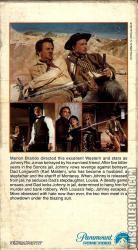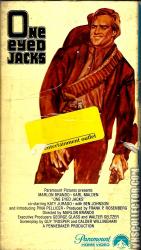One Eyed Jacks
Catalog Number
6537
-
Primary Distributor (If not listed, select "OTHER")
Catalog Number
6537
Primary Distributor (If not listed, select "OTHER")
Release Year
Country
141 mins (NTSC)
N/A | N/A | N/A
N/A | N/A
One Eyed Jacks (1961)
Additional Information
Additional Information
NOW THE SCREEN ACHIEVES SURPASSING GREATNESS!
The motion picture that starts its own tradition of greatness.
Western bandit Kid Rio (Marlon Brando) is betrayed by his partner, Dad Longworth (Karl Malden). Escaping from prison, Rio learns that Longworth has become a wealthy and influential lawman. Rio thirsts for revenge, but bides his time, waiting for the right moment to strike. In the meantime, Rio spitefully seduces Longworth's adopted daughter, Louisa (Pina Pellicer). After killing a man in self-defense, Rio is publicly whipped by the powerful Longworth. When Rio's old gang accidentally kills a child during another holdup, Longworth has the perfect excuse to eliminate the troublesome Rio once and for all by hanging him. But that's not what happens at all. Stripped to its fundamentals, One-Eyed Jacks is a workable Western, worthy of perhaps 90 minutes' running time. But when Marlon Brando succeeded Stanley Kubrick in the director's chair, he allowed the film's 60-day shooting schedule to stretch into six months, and delivered a finished product running in excess of four hours. The current 141-minute version of One-Eyed Jacks isn't as ponderous as some critics have claimed, but it's still too much of a good thing. While Brando the director isn't precisely in the Kubrick class, Brando the actor delivers one of his finest and most focused performances (though he is upstaged throughout by Karl Malden)
One-Eyed Jacks received mixed reviews from critics. Review aggregator Rotten Tomatoes reports that 50% critics have given the film a positive review, with a rating average of 6.2/10. Bosley Crowther of The New York Times, favorably influenced by Brando's efforts, noted: "... Directed and played with the kind of vicious style that Mr. Brando has put into so many of his skulking, scabrous roles. Realism is redolent in them, as it is in many details of the film. But, at the same time, it is curiously surrounded by elements of creamed-cliché romance and a kind of pictorial extravagance that you usually see in South Sea island films."[4] Variety, on the other hand, wrote: "It is an oddity of this film that both its strength and its weakness lie in the area of characterization. Brando's concept calls, above all, for depth of character, for human figures endowed with overlapping good and bad sides to their nature."[5] Dave Kehr of The Chicago Reader wrote: "There is a strong Freudian pull to the situation (the partner's name is “Dad”) that is more ritualized than dramatized: the most memorable scenes have a fierce masochistic intensity, as if Brando were taking the opportunity to punish himself for some unknown crime.
Release Date: April 5, 1961
Distrib: Paramount
The motion picture that starts its own tradition of greatness.
Western bandit Kid Rio (Marlon Brando) is betrayed by his partner, Dad Longworth (Karl Malden). Escaping from prison, Rio learns that Longworth has become a wealthy and influential lawman. Rio thirsts for revenge, but bides his time, waiting for the right moment to strike. In the meantime, Rio spitefully seduces Longworth's adopted daughter, Louisa (Pina Pellicer). After killing a man in self-defense, Rio is publicly whipped by the powerful Longworth. When Rio's old gang accidentally kills a child during another holdup, Longworth has the perfect excuse to eliminate the troublesome Rio once and for all by hanging him. But that's not what happens at all. Stripped to its fundamentals, One-Eyed Jacks is a workable Western, worthy of perhaps 90 minutes' running time. But when Marlon Brando succeeded Stanley Kubrick in the director's chair, he allowed the film's 60-day shooting schedule to stretch into six months, and delivered a finished product running in excess of four hours. The current 141-minute version of One-Eyed Jacks isn't as ponderous as some critics have claimed, but it's still too much of a good thing. While Brando the director isn't precisely in the Kubrick class, Brando the actor delivers one of his finest and most focused performances (though he is upstaged throughout by Karl Malden)
One-Eyed Jacks received mixed reviews from critics. Review aggregator Rotten Tomatoes reports that 50% critics have given the film a positive review, with a rating average of 6.2/10. Bosley Crowther of The New York Times, favorably influenced by Brando's efforts, noted: "... Directed and played with the kind of vicious style that Mr. Brando has put into so many of his skulking, scabrous roles. Realism is redolent in them, as it is in many details of the film. But, at the same time, it is curiously surrounded by elements of creamed-cliché romance and a kind of pictorial extravagance that you usually see in South Sea island films."[4] Variety, on the other hand, wrote: "It is an oddity of this film that both its strength and its weakness lie in the area of characterization. Brando's concept calls, above all, for depth of character, for human figures endowed with overlapping good and bad sides to their nature."[5] Dave Kehr of The Chicago Reader wrote: "There is a strong Freudian pull to the situation (the partner's name is “Dad”) that is more ritualized than dramatized: the most memorable scenes have a fierce masochistic intensity, as if Brando were taking the opportunity to punish himself for some unknown crime.
Release Date: April 5, 1961
Distrib: Paramount
Related Releases2
Catalog Number
9165
Primary Distributor (If not listed, select "OTHER")
One Eyed Jacks (1961)
Release Year
Catalog Number
9165
Primary Distributor (If not listed, select "OTHER")
Catalog Number
9165
Catalog Number
5459
Primary Distributor (If not listed, select "OTHER")
One Eyed Jacks (1961)
Release Year
Catalog Number
5459
Primary Distributor (If not listed, select "OTHER")
Catalog Number
5459












Comments0
Login / Register to post comments